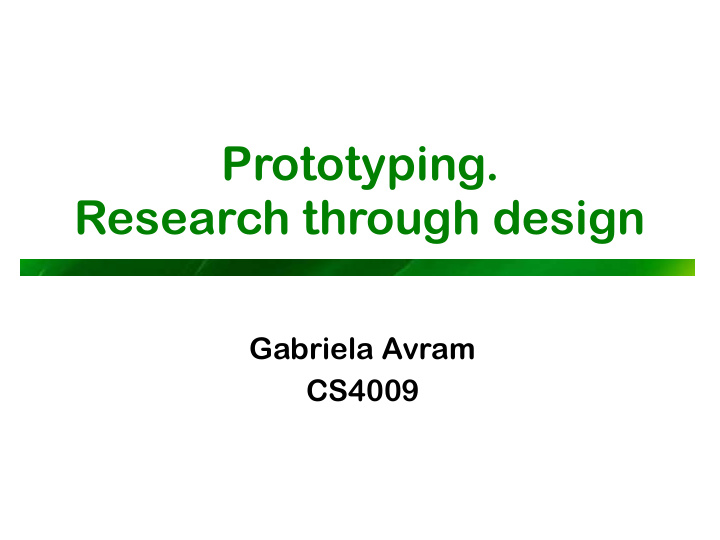



Prototyping. Research through design Gabriela Avram CS4009
Prototyping What is a prototype? • Why prototype? • Different kinds of prototyping • - Low fidelity - High fidelity Compromises in prototyping • - Vertical - Horizontal Final product needs to be engineered • www.id-book.com 2
What is a prototype? In other design fields a prototype is a small-scale model: • a miniature car • a miniature building or town • the examples here come from a 3D printer 3 www.id-book.com
4 www.id-book.com
What is a prototype? In interaction design it can be (among other things): • a series of screen sketches • a storyboard, i.e. a cartoon-like series of scenes • a Powerpoint slide show • a video simulating the use of a system • a lump of wood (e.g. PalmPilot) • a cardboard mock-up • a piece of software with limited functionality written in the target language or in another language 5 www.id-book.com
Why prototype? • Evaluation and feedback are central to interaction design • Stakeholders can see, hold, interact with a prototype more easily than a document or a drawing • Team members can communicate effectively • You can test out ideas for yourself • It encourages reflection: very important aspect of design • Prototypes answer questions, and support designers in choosing between alternatives 6 www.id-book.com
Filtering dimensions of prototyping 7 www.id-book.com
Manifestation dimensions of prototyping 8 www.id-book.com
What to prototype? • Technical issues • Work flow, task design • Screen layouts and information display • Difficult, controversial, critical areas 9 www.id-book.com
Low-fidelity Prototyping • Uses a medium which is unlike the final medium, e.g. paper, cardboard • Is quick, cheap and easily changed • Examples: ■ sketches of screens, task sequences, etc ■ ‘post-it’ notes ■ storyboards ■ ‘Wizard-of-Oz’ www.id-book.com 10
Storyboards • Often used with scenarios, bringing more detail, and a chance to role play • It is a series of sketches showing how a user might progress through a task using the device • Used early in design 11 www.id-book.com
Example storyboard (Alltemplate.me) 12
Sketching • Sketching is important to low-fidelity prototyping • Don’t be inhibited about drawing ability. Practice simple symbols www.id-book.com 14
Card-based prototypes • Index cards (3 X 5 inches) • Each card represents one screen or part of screen • Often used in website development www.id-book.com 15
Mobile app prototyping Mobile. Paper prototyping by flavio nazario - https://vimeo.com/38256134
‘Wizard-of-Oz’ prototyping • The user thinks they are interacting with a computer, but a developer is responding to output rather than the system. • Usually done early in design to understand users’ expectations • What is ‘wrong’ with this approach? User >Blurb blurb >Do this >Why? 16 www.id-book.com
Wizard of Oz - Stiftinator https://vimeo.com/132251871
Evaluating a prototype hci museum of random objects prototype - https://youtu.be/MKKx5SU- m9k
Prototyping with materials IDEO: Medtech Prototyping- https://youtu.be/Ii1rcNJU0io?t=181
3D printing 3d printed diffusers in the ATTIRE project - http://davidhunt.ie/attire/?page_id=281 p
Video prototyping p Audio interaction prototype - https://vimeo.com/326053692
Urban prototyping p https://vimeo.com/56350598
Sketching in hardware p The soldier’s bag – meSch Project - http://codesign.mesch.io/methods/453-2/index.htm
High-fidelity prototyping • Uses materials that you would expect to be in the final product • Prototype looks more like the final system than a low- fidelity version • High-fidelity prototypes can be developed by integrating existing hardware and software components • Danger that users think they have a complete system…….see compromises www.id-book.com 24
High fidelity prototype https://1stwebdesigner.com/difference-wireframes-and-prototypes/ p
Compromises in prototyping • All prototypes involve compromises • For software-based prototyping maybe there is a slow response? sketchy icons? limited functionality? • Two common types of compromise • horizontal: provide a wide range of functions, but with little detail • vertical: provide a lot of detail for only a few functions • Compromises in prototypes mustn't be ignored. Product needs engineering 26 www.id-book.com
Research Through Design p Research through Design (RtD) is an approach to conducting scholarly research that employs the methods, practices, and processes of design practice with the inten- tion of generating new knowledge. People carrying out research using RtD gener- ally reject the idea that research is synonymous with science. Instead, RtD frames design inquiry as a distinctly separate activity from engineering inquiry and scien- tific inquiry. (Zimmerman and Forlizzi 2007)
Critical Design p Critical design takes a critical theory based approach to design. This kind of design uses design fiction and speculative design proposals to challenge assumptions, conceptions about the role of objects play in everyday life. Critical design object plays a role of product design, but emphasizes on neither commercial purpose nor physical utility. It is mainly for sharing a critical perspective and carrying debate to the public, to increase awareness on social, cultural, or ethical issues by asking questions to the public. Critical design is popularized by Anthony Dunne and Fiona Raby (Wikipedia on Critical Design).
Design fiction A machine. Learning- https://youtu.be/XXAs3pfPBTY p
Readings • Joseph Lindley and Robert Potts. 2014. A machine learning: an example of HCI prototyping with design fiction. In Proceedings of the 8th Nordic Conference on Human-Computer Interaction: Fun, Fast, Foundational (NordiCHI '14). ACM, New York, NY, USA, 1081-1084. DOI: https:// doi.org/10.1145/2639189.2670281 • Mark Blythe. 2017. Research Fiction: Storytelling, Plot and Design. In Proceedings of the 2017 CHI Conference on Human Factors in Computing Systems (CHI '17). ACM, New York, NY, USA, 5400-5411. DOI: https:// doi.org/10.1145/3025453.3026023 • Mark Blythe and Enrique Encinas. 2016. The Co-ordinates of Design Fiction: Extrapolation, Irony, Ambiguity and Magic. In Proceedings of the 19th International Conference on Supporting Group Work (GROUP '16). ACM, New York, NY, USA, 345-354. DOI: https://doi.org/ 10.1145/2957276.2957299
Recommend
More recommend